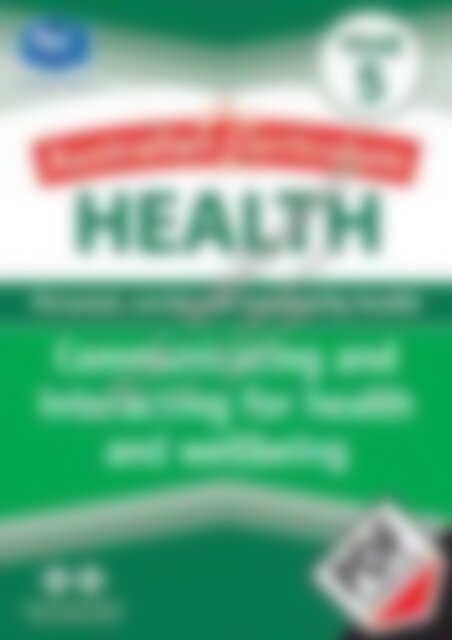RIC-20016 AC Health (Year 5) Communicating for health and wellbeing
You also want an ePaper? Increase the reach of your titles
YUMPU automatically turns print PDFs into web optimized ePapers that Google loves.
©R.I.C. Publications<br />
Low Resolution Images<br />
Display Copy
Australian Curriculum <strong>Health</strong> (<strong>Year</strong> 5)<br />
Published by R.I.C. Publications ® 2016<br />
Copyright @ R.I.C. Publications 2016<br />
<strong>RIC</strong>- <strong>20016</strong><br />
Copyright Notice<br />
A number of pages in this book are worksheets.<br />
The publisher licenses the individual teacher<br />
who purchased this book to photocopy these<br />
pages to h<strong>and</strong> out to students in their own<br />
classes.<br />
Titles in this series:<br />
Australian Curriculum <strong>Health</strong> (Foundation)<br />
Australian Curriculum <strong>Health</strong> (<strong>Year</strong> 1)<br />
Australian Curriculum <strong>Health</strong> (<strong>Year</strong> 2)<br />
Australian Curriculum <strong>Health</strong> (<strong>Year</strong> 3)<br />
Australian Curriculum <strong>Health</strong> (<strong>Year</strong> 4)<br />
Australian Curriculum <strong>Health</strong> (<strong>Year</strong> 5)<br />
Australian Curriculum <strong>Health</strong> (<strong>Year</strong> 6)<br />
All material identified by O is material subject to copyright<br />
under the Copyright Act 1968 (Cth) <strong>and</strong> is owned by the Australian<br />
Curriculum, Assessment <strong>and</strong> Reporting Authority 2016.<br />
For all Australian Curriculum material except elaborations: This is<br />
an extract from the Australian Curriculum.<br />
Elaborations: This may be a modified extract from the Australian<br />
Curriculum <strong>and</strong> may include the work of other authors.<br />
Disclaimer: <strong>AC</strong>ARA neither endorses nor verifies the accuracy of the<br />
in<strong>for</strong>mation provided <strong>and</strong> accepts no responsibility <strong>for</strong> incomplete or<br />
inaccurate in<strong>for</strong>mation.<br />
In particular, <strong>AC</strong>ARA does not endorse or verify that:<br />
• The content descriptions are solely <strong>for</strong> a particular year <strong>and</strong><br />
subject;<br />
• All the content descriptions <strong>for</strong> that year <strong>and</strong> subject have been<br />
used;<strong>and</strong><br />
• The author's material aligns with the Australian Curriculum content<br />
descriptions <strong>for</strong> the relevant year <strong>and</strong> subject.<br />
You can find the unaltered <strong>and</strong> most up to date version of this<br />
material at http://www.australiancurriculum.edu.au/<br />
This material is reproduced with the permission of <strong>AC</strong>ARA.<br />
Cft<br />
I Australian<br />
gw CUR<strong>RIC</strong>ULUM<br />
Except as allowed under the Copyright Act 1968,<br />
any other use (including digital <strong>and</strong> on line uses<br />
<strong>and</strong> the creation of overhead transparencies<br />
or posters) or any use by or <strong>for</strong> other people<br />
(including by or <strong>for</strong> other teachers, students or<br />
institutions) is prohibited. If you want a licence<br />
to do anything outside the scope of the BLM<br />
licence above, please contact the Publisher.<br />
This in<strong>for</strong>mation is provided to clarify the limits<br />
of this licence <strong>and</strong> its interaction with the<br />
Copyright Act.<br />
For your added protection in the case of<br />
copyright inspection, please complete the <strong>for</strong>m<br />
below. Retain this <strong>for</strong>m, the complete original<br />
document <strong>and</strong> the invoice or receipt as proof<br />
of purchase.<br />
Name of Purchaser:<br />
Date of Purchase:<br />
Supplier:<br />
School Order# (if applicable):<br />
Signature of Purchaser:<br />
©R.I.C. Publications<br />
Low Resolution Images<br />
Display Copy<br />
Internet websites<br />
In some cases, websites or specific UR Ls may be recommended. While these are checked <strong>and</strong> rechecked at the time of publication,<br />
the publisher has no control over any subsequent changes which may be made to webpages. It is strongly recommended that the<br />
class teacher checks all URLs be<strong>for</strong>e allowing students to access them.<br />
View all pages online<br />
PO Box 332 Greenwood Western Australia 6924<br />
Website: www.ricpublications.com.au<br />
Email: mail@ricpublications.com.au<br />
R.I.C. PUBLICATIONS<br />
YOUR PARTNER IN EDUCATION<br />
AUSTRALIAN<br />
PRIMARY PUBLISHER<br />
OF THE YEAR<br />
2015 & 2016
. FOREWORD.<br />
Australian Curriculum <strong>Health</strong> is a seven-book<br />
series designed to support the teaching <strong>and</strong> learning<br />
of the Personal, social <strong>and</strong> community <strong>health</strong> str<strong>and</strong> of<br />
Australian Curriculum <strong>Health</strong> <strong>and</strong> Physical Education.<br />
Written in lesson-plan <strong>for</strong>mat, the series provides<br />
a variety of teacher resources to assist in the<br />
implementation of <strong>health</strong> lessons .<br />
. C:ONTENTs···<br />
.....<br />
Teachers notes ................................................................................................................................... iv-v<br />
Being <strong>health</strong>y, safe <strong>and</strong> active ...................................................................................................... 2-37<br />
Identity ................................................................................................................................................. 2-5<br />
Puberty ................................................................................................................................................ 6-9<br />
<strong>Health</strong> in<strong>for</strong>mation .. .. ....................................................................................................................... I 0-13<br />
Anti-drugs <strong>and</strong> alcohol ..................................................................................................................... 14-17<br />
<strong>Health</strong>y eating .................................................................................................................................. 18-21<br />
Nutritional in<strong>for</strong>mation ...................................................................................................................... 22-25<br />
Increasing fitness ............................................................................................................................. 26-29<br />
Water <strong>and</strong> road safety ..................................................................................................................... 30-33<br />
Cyber safety ..................................................................................................................................... 34-37<br />
©R.I.C. Publications<br />
Low Resolution Images<br />
Display Copy<br />
<strong>Communicating</strong> <strong>and</strong> interacting <strong>for</strong> <strong>health</strong> <strong>and</strong> <strong>wellbeing</strong> ........................................................ 38-57<br />
Changing relationships .................................................................................................................... 38-41<br />
Skills to manage bullying ................................................................................................................. 42-45<br />
Sharing power ................................................................................................................................. 46-49<br />
Emotional responses ....................................................................................................................... 50-53<br />
Media influence ............................................................................................................................... 54-57<br />
Contributing to <strong>health</strong>y <strong>and</strong> active communities ....................................................................... 58-81<br />
Promoting safety .............................................................................................................................. 58-61<br />
Promoting physical <strong>health</strong> ............................................................................................................... 62-65<br />
Promoting mental <strong>wellbeing</strong> ............................................................................................................. 66-69<br />
Connecting outdoors ....................................................................................................................... 70-73<br />
Fighting discrimination <strong>and</strong> racism ................................................................................................... 74-77<br />
Diversity <strong>and</strong> inclusion ...................................................................................................................... 78-81<br />
R.I.C. Publications ® www.ricpublications.com.au Australian Curriculum <strong>Health</strong> (<strong>Year</strong> 5) Ill
:<br />
:<br />
:<br />
This comprehensive teacher resource is divided into 20 units which cover the three <strong>health</strong> sub-str<strong>and</strong>s-Being<br />
<strong>health</strong>y, safe <strong>and</strong> active; <strong>Communicating</strong> <strong>and</strong> interacting <strong>for</strong> <strong>health</strong> <strong>and</strong> <strong>wellbeing</strong>; <strong>and</strong> Contributing to <strong>health</strong>y <strong>and</strong><br />
active communities.<br />
Each sub-str<strong>and</strong> section contains a varied number of units.<br />
Each unit contains a teachers page <strong>and</strong> three supporting pages.<br />
TE<strong>AC</strong>HERS PAGE<br />
+ The title of the unit is provided...............<br />
r··<br />
..• 1den111y<br />
:::;,;,:···················r;;;:J---<br />
---placN(<strong>AC</strong>PPIIO0<br />
is stated<br />
=.:a-J:=<br />
asm,o, ____ .__<br />
------aldmJOX,da<br />
now"Hawl>as)'O!Kidon/Jlydr,fll'dalOIO-<br />
DD-<br />
3. Utingtioa,.:,lobelow,in
Pages<br />
2-5<br />
6-9<br />
10-13<br />
14-17<br />
18-21<br />
22-25<br />
26-29<br />
30-33<br />
34-37<br />
38-41<br />
42-45<br />
46-49<br />
50-53<br />
54-57<br />
58-61<br />
62-65<br />
66-69<br />
70-73<br />
74-77<br />
78-81<br />
..<br />
Ill<br />
C,<br />
::,<br />
'O<br />
..<br />
G)<br />
.c- 0<br />
'O<br />
C<br />
C<br />
0<br />
.c<br />
86'<br />
ciS.<br />
<br />
·s; :,;::<br />
CJ<br />
C<br />
C<br />
CJ<br />
'iii<br />
>-<br />
.c<br />
Q.<br />
C ....<br />
0 0<br />
:,;::<br />
·;:<br />
Ill<br />
- -<br />
:::, ;;:::::<br />
C<br />
G)<br />
C<br />
'O<br />
G)<br />
C<br />
C<br />
-o_<br />
.c_<br />
.c cc<br />
= 0.<br />
Oz cm<br />
0 LL<br />
LL-<br />
G) :c<br />
C,<br />
C<br />
·a; :e<br />
Q)<br />
,:<br />
'O<br />
C<br />
C<br />
.c<br />
:!::<br />
C<br />
G)<br />
.c<br />
c--<br />
C :C<br />
:c-<br />
:ii:-<br />
G) :ii:<br />
Ill<br />
G)<br />
:,;::<br />
·s;<br />
= E C<br />
Ill :,;::<br />
>- G) CJ<br />
c<br />
0 G)<br />
:::, CJ) :::,<br />
>< ... -<br />
G) 0 C<br />
Ill C G)<br />
'O<br />
><br />
C ·e 'O<br />
C<br />
'O<br />
C<br />
Ill C 'O<br />
Q.<br />
C C<br />
>-<br />
C<br />
.c<br />
Ill 0 G)<br />
C C,<br />
ii<br />
0 C<br />
G)<br />
:,;:: <br />
- Cl) C c:(<br />
c- .! :,;:: ii:'<br />
=-<br />
G) a: c- 5. .c 0<br />
a:- Cl) o-<br />
..<br />
C<br />
G)<br />
E<br />
G)<br />
><br />
0<br />
:Si2<br />
Ill E<br />
Ill G)<br />
-<br />
G)<br />
:,;::<br />
C<br />
><br />
G)<br />
·s; 'iii<br />
:,;:: Ill<br />
E CJ<br />
G)<br />
Ill C<br />
> -<br />
Q.<br />
0 .. c ><<br />
E 0 CJ G)<br />
Q.<br />
Ill 'iii 'O<br />
C >- C<br />
- 'O<br />
C<br />
.c C<br />
C<br />
G)<br />
Q.<br />
C -<br />
C,<br />
E<br />
Ill<br />
c- G)<br />
c E<br />
.c<br />
C:E<br />
CCI) .! >-w<br />
u.- :::, LL CJ ·-<br />
...J-_.<br />
.ca: a:-<br />
'O Cl)<br />
e- .2 0. --<br />
©R.I.C. Publications<br />
Low Resolution Images<br />
Display Copy<br />
R.I.C. Publications ® www.ricpublications.com.au<br />
Australian Curriculum <strong>Health</strong> (<strong>Year</strong> 5)<br />
v
,, .. c11ang1ng relationships<br />
<strong>Communicating</strong> <strong>and</strong> interacting <strong>for</strong> <strong>health</strong> <strong>and</strong> <strong>wellbeing</strong><br />
The lesson<br />
Introduction<br />
• What is a relationship? Students <strong>for</strong>m small<br />
groups <strong>and</strong> discuss the answer. Using page 39<br />
(one sheet per group), each student writes their<br />
own answer on a jigsaw piece. Glue all pieces<br />
together on a piece of card. Students can<br />
write more than one answer depending on the<br />
number of students in the group.<br />
• What does it mean to have a relationship?<br />
Watch the video at <br />
to see what other think. Do you agree with the<br />
children in the video?<br />
Development<br />
• Who do you have a relationship with? Students<br />
individually create a word web using poster<br />
paper or page 40, listing at least four people<br />
they have a relationship with.<br />
• What would cause a change to the relationship?<br />
Add suggestions to the word web about what<br />
changes could occur; e.g. a best friend may<br />
move interstate, you may not have the same<br />
interests as your friend anymore, a gr<strong>and</strong>parent<br />
may die, parents may get divorced <strong>and</strong> so on.<br />
• Do you think relationships are important? How<br />
can they benefit you? Display page 41 on a<br />
whiteboard <strong>and</strong> add any more benefits students<br />
can think of.<br />
Differentiation<br />
The whole lesson can be conducted<br />
individually, in small groups or as a whole class<br />
as time or ability allows.<br />
Conclusion<br />
• In small groups, students share the most<br />
interesting thing they learnt in the lesson <strong>and</strong><br />
compile a top three list. Groups then present<br />
their list to the class.<br />
Content description<br />
Practise skills to establish <strong>and</strong> manage<br />
relationships (<strong>AC</strong>PPS055) G<br />
Resources<br />
• http://tinyurl.com/zeaf26c<br />
• Sufficient copies of page 39<br />
• Sufficient A3 copies of page 40 or poster paper<br />
• Scan page 41 or provide sufficient A3 copies<br />
Assessment<br />
• Can the student describe what a relationship is?<br />
• Can the student identify people they have a<br />
relationship with?<br />
• Can the student identify what changes may occur to<br />
relationships?<br />
• Can the student identify the impact of relationships<br />
on their <strong>health</strong> <strong>and</strong> <strong>wellbeing</strong>?<br />
Going further<br />
• Discuss the difference between <strong>health</strong>y <strong>and</strong><br />
un<strong>health</strong>y relationships using a T-chart. What is<br />
the impact on your <strong>health</strong> if your relationships are<br />
un<strong>health</strong>y? Answers could include feeling physically<br />
ill, stressed, leading to high blood pressure, low<br />
confidence or self-esteem.<br />
• Practise ways to make new friends <strong>and</strong> start new<br />
relationships. Students can write their favourite<br />
food, sport, TV show, musician, hobby, school<br />
subject <strong>and</strong> so on, then find a person in the class<br />
who they have something in common with.<br />
©R.I.C. Publications<br />
Low Resolution Images<br />
Display Copy<br />
38 Australian Curriculum <strong>Health</strong> (<strong>Year</strong> 5) R.I.C. Publications ® www.ricpublications.com.au
,, .. €han9in9 relationships::.. 1<br />
<strong>Communicating</strong> <strong>and</strong> interacting <strong>for</strong> <strong>health</strong> <strong>and</strong> <strong>wellbeing</strong><br />
©R.I.C. Publications<br />
Low Resolution Images<br />
Display Copy<br />
R.I.C. Publications ® www.ricpublications.com.au<br />
Australian Curriculum <strong>Health</strong> (<strong>Year</strong> 5) 39
,, .. EhanQii19 relatioiiSfiips - 2<br />
<strong>Communicating</strong> <strong>and</strong> interacting <strong>for</strong> <strong>health</strong> <strong>and</strong> <strong>wellbeing</strong><br />
©R.I.C. Publications<br />
Low Resolution Images<br />
Display Copy<br />
40 Australian Curriculum <strong>Health</strong> (<strong>Year</strong> 5)<br />
R.I.C. Publications ® www.ricpublications.com.au
,, Chaiiging relationships ..:. 3 ·;<br />
<strong>Communicating</strong> <strong>and</strong> interacting <strong>for</strong> <strong>health</strong> <strong>and</strong> <strong>wellbeing</strong><br />
Bemfiis of lttu1<br />
relalioH-Sltips am/,sodal<br />
toHJ1UlioH-S<br />
©R.I.C. Publications<br />
Low Resolution Images<br />
Display Copy<br />
Livelo 119<br />
er<br />
R.I.C. Publications ® www.ricpublications.com.au<br />
Australian Curriculum <strong>Health</strong> (<strong>Year</strong> 5) 41
<strong>Communicating</strong> <strong>and</strong> interacting <strong>for</strong> <strong>health</strong> <strong>and</strong> <strong>wellbeing</strong><br />
The lesson<br />
Introduction<br />
• What is bullying? Why do people bully? What<br />
effect does bullying have on people? Write<br />
each of these questions on a separate piece<br />
of poster paper <strong>and</strong> place in three areas of the<br />
room. Divide the class into three groups <strong>and</strong><br />
give each group a different-coloured marker.<br />
Groups assign a scribe <strong>and</strong> write what they<br />
know about each question, <strong>and</strong> then rotate to<br />
the next question, taking their marker with them.<br />
Be<strong>for</strong>e answering the question they must read<br />
the responses written by the previous group (or<br />
groups).<br />
Development<br />
• Introduce the website <strong>and</strong> show students<br />
how to navigate around it, including clicking on<br />
'Facts about bullying', 'I am being bullied' <strong>and</strong><br />
so on.<br />
• Students research to find the answer to what<br />
bullying is <strong>and</strong> why people bully, using any of<br />
the topics in the 'I am 13 or younger' section.<br />
They should record their findings on page 43.<br />
• What effect does bullying have on people?<br />
Allow students time to explore the website<br />
.<br />
Ask students to volunteer to write a negative<br />
effect on a sticky note <strong>and</strong> collate them on a<br />
large piece of paper to display in the classroom.<br />
• What can you do if you are being bullied?<br />
In small groups students create a video<br />
presentation of steps to take if they are being<br />
bullied, similar in style to the videos shown at<br />
. Use research<br />
from the Take a st<strong>and</strong> together website <strong>and</strong><br />
other reliable sources. Plan the video using<br />
page 44.<br />
Differentiation<br />
Activities can be done individually or in small<br />
groups. Alternatively, if the appropriate ICT is<br />
not available, students can create a classroom<br />
poster that gives students steps to take if they<br />
are being bullied.<br />
Conclusion<br />
• Students call out physical <strong>and</strong> mental effects<br />
bullying has. Share their video or poster with<br />
the class.<br />
Content description<br />
Practise skills to establish <strong>and</strong> manage<br />
relationships (<strong>AC</strong>PPS055) 0<br />
Resources<br />
• http://www.takeast<strong>and</strong>together.gov.au/<br />
• Sufficient copies of pages 43-45<br />
• Poster paper, markers<br />
Assessment<br />
• Use page 45.<br />
• Can the student describe what bullying is?<br />
• Can the student identify the impact of bullying on<br />
mental <strong>and</strong> physical <strong>health</strong>?<br />
• Can the student suggest <strong>and</strong> describe strategies to<br />
deal with bullies?<br />
Going further<br />
• Explore what can be done if students see others<br />
being bullied. Compare the actions of a byst<strong>and</strong>er<br />
to the actions of a victim of bullying. What is an<br />
active byst<strong>and</strong>er? This website may be useful:<br />
.<br />
• Conduct role-plays to show what a byst<strong>and</strong>er could<br />
do, <strong>and</strong> what the victim can do.<br />
• Watch a video about what makes a good digital<br />
citizen at . Discuss<br />
what is the same <strong>and</strong> different about cyberbullying<br />
compared to bullying. Explore what skills are<br />
needed to stay cyber safe <strong>and</strong> what practices make<br />
a good digital citizen.<br />
©R.I.C. Publications<br />
Low Resolution Images<br />
Display Copy<br />
42 Australian Curriculum <strong>Health</strong> (<strong>Year</strong> 5) R.I.C. Publications ® www.ricpublications.com.au
..,.<br />
·-··skmS·to manage bullyinQ::.··r·<br />
<strong>Communicating</strong> <strong>and</strong> interacting <strong>for</strong> <strong>health</strong> <strong>and</strong> <strong>wellbeing</strong><br />
Go to <strong>and</strong> click on the 'I am 13 or younger'<br />
button.<br />
Research the website to find answers to the questions posed earlier.<br />
I/Iha/is bu"'tut9?<br />
©R.I.C. Publications<br />
Low Resolution Images<br />
Display Copy<br />
R.I.C. Publications ® www.ricpublications.com.au Australian Curriculum <strong>Health</strong> (<strong>Year</strong> 5) 43
·-··sitmS to manage b'iillyinQ-::.. ;2·· ... .. ,.,<br />
Research notes/ideas:<br />
<strong>Communicating</strong> <strong>and</strong> interacting <strong>for</strong> <strong>health</strong> <strong>and</strong> <strong>wellbeing</strong><br />
Tille of presentotion:<br />
[<br />
Card I<br />
Card 2<br />
Card 3<br />
Card 6<br />
Card 7<br />
Card 8<br />
©R.I.C. Publications<br />
Low Resolution Images<br />
Display Copy<br />
Card 4<br />
Card 9<br />
Card 5<br />
Card 10<br />
44 Australian Curriculum <strong>Health</strong> (<strong>Year</strong> 5)<br />
R.I.C. Publications ® www.ricpublications.com.au
,, .. Skills tO manage b'Ullying""- 3<br />
I. What is bullying?<br />
<strong>Communicating</strong> <strong>and</strong> interacting <strong>for</strong> <strong>health</strong> <strong>and</strong> <strong>wellbeing</strong><br />
2. Explain why each of the following strategies would work if you were in a situation where<br />
you were being bullied.<br />
(a) Ignore the bully <strong>and</strong> walk away.<br />
(b) Respond with confidence.<br />
(c) Tell someone <strong>and</strong> seek help.<br />
3. Tick which of the following effects you think bullying can have on a victim.<br />
D headaches<br />
©R.I.C. Publications<br />
Low Resolution Images<br />
Display Copy<br />
D low self-esteem<br />
D feeling stressed/anxious<br />
D thoughts of self-harm<br />
D feel respected<br />
D more confidence<br />
D trouble sleeping at night<br />
D depression <strong>and</strong> sadness<br />
D loss of appetite<br />
D withdrawing from social situations<br />
D lack of concentration<br />
D feeling ashamed <strong>and</strong> embarrassed<br />
R.I.C. Publications ® www.ricpublications.com.au<br />
Australian Curriculum <strong>Health</strong> (<strong>Year</strong> 5) 45
<strong>Communicating</strong> <strong>and</strong> interacting <strong>for</strong> <strong>health</strong> <strong>and</strong> <strong>wellbeing</strong><br />
The lesson<br />
Introduction<br />
• What is power? Look at the quotes from famous<br />
people throughout history on page 47. The page<br />
can be displayed on a whiteboard. In groups,<br />
students discuss what they think the quotes<br />
mean.<br />
• Students come up with their own description of<br />
what power is in a <strong>health</strong>y relationship.<br />
Development<br />
• What are some examples of power? Look at<br />
the examples on page 47 <strong>and</strong> discuss. The<br />
page can be displayed on a whiteboard. Draw a<br />
T-chart <strong>and</strong> sort the examples into two groups.<br />
• What is the difference between the two groups?<br />
Discuss 'personal power' versus 'power over<br />
others' <strong>and</strong> assign the correct heading to each<br />
group. Add any other examples the students<br />
can think of.<br />
• Discuss power in terms of win-win <strong>and</strong> winlose<br />
situations. What is an example of a winwin<br />
situation? Who has the power? What is an<br />
example of a win-lose situation? Who has the<br />
power? Which is the ideal outcome?<br />
• Individually complete page 48.<br />
Differentiation<br />
Activities can be done in small groups or as<br />
a whole class. Page 47 can be photocopied<br />
instead of displayed on the whiteboard.<br />
Conclusion<br />
• Toss a ball to students to share their answers<br />
to questions 3 <strong>and</strong> 4 from page 48. Students<br />
continue to toss the ball to each other until<br />
everyone has shared.<br />
<br />
Content description<br />
Practise skills to establish <strong>and</strong> manage<br />
relationships (<strong>AC</strong>PPS055) G<br />
Resources<br />
• Scan page 47<br />
• Sufficient copies of page 48<br />
Answers<br />
Page 47<br />
Personal power: good self-esteem; showing<br />
respect <strong>and</strong> being respected in return; being<br />
assertive <strong>and</strong> having a voice; cooperative; listening<br />
to others' views; making others feel good about<br />
themselves; allowing others to feel powerful<br />
Power over others: being aggressive; being a bully;<br />
dominant; destructive <strong>and</strong> intimidating behaviour;<br />
being unfair to gain an advantage; untrustworthy;<br />
hurting others' feelings; making others feel weak<br />
<strong>and</strong> unimportant<br />
Assessment<br />
• Can the student differentiate between personal<br />
power <strong>and</strong> power over others?<br />
• Can the student provide examples of the<br />
different types of power?<br />
• Can the student differentiate between win-win<br />
situations <strong>and</strong> win-lose situations?<br />
• Can the student suggest appropriate ways to<br />
share power?<br />
©R.I.C. Publications<br />
Low Resolution Images<br />
Display Copy<br />
Going further<br />
• For further practice identifying personal power<br />
<strong>and</strong> win-win situations versus power over others<br />
<strong>and</strong> win-lose situations, play the board game<br />
on page 49. Students can suggest solutions to<br />
balance the power in the scenarios presented.<br />
<br />
46 Australian Curriculum <strong>Health</strong> (<strong>Year</strong> 5) R.I.C. Publications ® www.ricpublications.com.au
Quotes about power ...<br />
<strong>Communicating</strong> <strong>and</strong> interacting <strong>for</strong> <strong>health</strong> <strong>and</strong> <strong>wellbeing</strong><br />
Whal makes Superman a her() is ;wf /Ital he has p()wer, but /Ital he has llte wisdtJm<br />
<strong>and</strong>lltemalurift/ lo uselltep()wer wiseq.<br />
- Christopher Reeve<br />
V()u havep()WeJ'()flff 'l<br />
()urmittd-;wf()u/sideeveJtls. Realiselltis, <strong>and</strong> 11<br />
()u wi/1,<br />
fotd slrett9-llt.<br />
- Marcus Aurelius<br />
E11er11 daf wehavepknh( rf ()pp()r/unilies lo 9elatt9rl/, slressed()r o/fetded 8ufwhal 11<br />
()u'redtJut9, when<br />
1/()U induelltese!tf!9aliveemtJ!itJns is 9ivut9, S()melltut9, ()U/side 'l<br />
()ursef p()wer ()fie/' 1/()Uf h ap<br />
piness. V()u<br />
can CM()()Se lo Ml /d lill/,e lltut9s upset 1/()U.<br />
- Joel Osteen<br />
P()wer is rf /w() kinds. One is ()bfainedb 'I<br />
lltefear rf punishmen! <strong>and</strong>llte ()/1,er b 'I<br />
ads rf lo11e. P()wer based<br />
()1t/o11eis a /1,()us<strong>and</strong>limes l?Wre e/fedwe<strong>and</strong>permattbtilltan/lte()ne derivedfr()mfear rf punishmbt!.<br />
- Mahatma G<strong>and</strong>hi<br />
- Lao Tzu<br />
- Margaret Thatcher<br />
©R.I.C. Publications<br />
Low Resolution Images<br />
Display Copy<br />
being aggressive<br />
good self-esteem<br />
showing respect <strong>and</strong> being respected in<br />
return<br />
being a bully<br />
being assertive <strong>and</strong> having a voice<br />
cooperative<br />
dominant<br />
destructive <strong>and</strong> intimidating behaviour<br />
being unfair to gain an advantage<br />
listening to others' views<br />
untrustworthy<br />
making others feel good about themselves<br />
hurting others' feelings<br />
allowing others to feel powerful<br />
making others feel weak <strong>and</strong> unimportant<br />
R.I.C. Publications ® www.ricpublications.com.au<br />
Australian Curriculum <strong>Health</strong> (<strong>Year</strong> 5) 47
,, . Shcli'foQ j>Ower<br />
. .:: 2·· ···- .. . .. ,<br />
<strong>Communicating</strong> <strong>and</strong> interacting <strong>for</strong> <strong>health</strong> <strong>and</strong> <strong>wellbeing</strong><br />
In a relationship, power should be shared<br />
<strong>and</strong> balanced. That way everyone wins<br />
<strong>and</strong> the relationship is <strong>health</strong>y.<br />
I. Draw arms on the first set of scales to<br />
show the balance of power.<br />
When someone uses power over another<br />
person the relationship becomes<br />
unbalanced. This results in a win-lose<br />
situation because only one person ends<br />
up the winner. This is not a <strong>health</strong>y<br />
relationship.<br />
2. Draw arms on the second set of scales<br />
to show the balance of power.<br />
3. Write an example of a time when you<br />
have used power over another person<br />
or when someone else has used power<br />
over you. How did it feel?<br />
In a <strong>health</strong>y relationship, our personal power should be shared <strong>and</strong> result in a win-win<br />
situation where everybody is happy. When someone uses power over another person<br />
it ends up in a win-lose situation where one person feels bad.<br />
If. Look at the following situations <strong>and</strong> write one example of a win-win solution <strong>and</strong> one<br />
example of a win-lose solution .<br />
©R.I.C. Publications<br />
Low Resolution Images<br />
Display Copy<br />
• ----------------------<br />
·---------------------<br />
• ----------------------<br />
·---------------------<br />
48 Australian Curriculum <strong>Health</strong> (<strong>Year</strong> 5)<br />
R.I.C. Publications ® www.ricpublications.com.au
E<br />
!"\<br />
<br />
<br />
18<br />
i<br />
::!.<br />
-8<br />
C:<br />
g:<br />
<br />
0<br />
Bl<br />
8<br />
3<br />
i,,<br />
C:<br />
r<br />
i<br />
if<br />
::I<br />
" ::::<br />
a<br />
i:<br />
a<br />
,!::!<br />
<br />
[START]<br />
You get to school early <strong>and</strong><br />
decide to ask the new student<br />
to join you in a game. You have<br />
_ made them really happy <strong>and</strong><br />
more relaxed.<br />
"'-i?,J<br />
i,V Move FORWARD 1 space.<br />
At lunch you notice that the<br />
new kid is eating a strange<br />
meal from his home country.<br />
You shout out to the whole<br />
class to stay away from the<br />
smelly new kid.<br />
Go B<strong>AC</strong>K 6 spaces.<br />
You are having a<br />
bad day <strong>and</strong> are<br />
taking it out on<br />
others.<br />
Miss a turn.<br />
You are frozen<br />
with indecision<br />
<strong>and</strong> lack of<br />
confidence.<br />
Miss a turn.<br />
Power play<br />
There is only one seat left<br />
next to you on the bus, but<br />
you decide to put your school<br />
bag on it so no one can sit<br />
next to you.<br />
Go B<strong>AC</strong>K 4 spaces.<br />
At lunchtime you realise there<br />
is only one soccer ball so<br />
decide to play a quick game<br />
<strong>and</strong> then pass the ball on to<br />
other groups to share.<br />
Move FORWARD 5 spaces.<br />
During lunch the teacher<br />
gives you four sweets to<br />
pass on to your team as a<br />
reward <strong>for</strong> good behaviour in<br />
class. You decide to eat them<br />
all instead, knowing they'll<br />
never find out.<br />
Move B<strong>AC</strong>K 2 spaces.<br />
You are feeling<br />
confident <strong>and</strong><br />
assertive.<br />
You deserve<br />
another turn.<br />
©R.I.C. Publications<br />
Low Resolution Images<br />
Display Copy<br />
You cannot agree on<br />
how to split up chores<br />
with your sister <strong>and</strong><br />
then refuse to do any.<br />
Move B<strong>AC</strong>K 5 spaces.<br />
During groupwork in<br />
class, you ignore<br />
others' opinions <strong>and</strong><br />
appoint yourself as<br />
the group leader.<br />
Go B<strong>AC</strong>K 4 spaces.<br />
You threaten a girl at<br />
school that you will<br />
spread a nasty<br />
rumour about her if<br />
she doesn't help you<br />
with your homework.<br />
Go B<strong>AC</strong>K 5 spaces.<br />
Your positive energy<br />
<strong>and</strong> smile are<br />
infectious.<br />
You deserve<br />
another turn.<br />
You agree to help a<br />
classmate with history<br />
homework, which is<br />
your strongest subject,<br />
in return <strong>for</strong> help with<br />
maths. You both think<br />
this is a great deal.<br />
Move FORWARD 4<br />
FINISH<br />
b' 33<br />
C<br />
=<br />
[<br />
;·<br />
IQ<br />
DI<br />
=<br />
C.<br />
I<br />
cil<br />
Q.<br />
;·<br />
IQ<br />
c' ...<br />
=-<br />
s:<br />
;:::;:'<br />
=<br />
DI<br />
=<br />
C.<br />
!<br />
o=<br />
II)<br />
;·<br />
IQ<br />
- •<br />
... rt:<br />
<br />
<br />
11111111<br />
-·<br />
._.... :::s<br />
,_.,,. ...<br />
.... i<br />
'-'''<br />
0,.<br />
=ei<br />
n><br />
11111111<br />
I
,,. Emotion·a1 'responses<br />
<strong>Communicating</strong> <strong>and</strong> interacting <strong>for</strong> <strong>health</strong> <strong>and</strong> <strong>wellbeing</strong><br />
The lesson<br />
Introduction<br />
• Go to an online music player like . Search <strong>for</strong> songs about anger such<br />
as: 'TNT' by <strong>AC</strong>/DC, 'We're not gonna take it' by<br />
Twisted Sister, 'Caught out there' by Kelis, 'So what'<br />
by Pink, 'Riot' by Three Days Grace (first verse<br />
only), 'Don't look back in anger' by Oasis, 'Harder<br />
to breathe' by Maroon 5, 'Best of you' by the Foo<br />
Fighters etc.<br />
• Play appropriate snippets of each song such as the<br />
chorus <strong>and</strong> use radio-friendly versions of the songs<br />
to avoid any explicit lyrics.<br />
• What are emotions? What emotions can you hear in<br />
the songs? Do they have the same theme? Which<br />
song makes you feel the angriest?<br />
Development<br />
• Look at the anger thermometer on page 51 <strong>and</strong><br />
discuss the different levels of anger.<br />
• When is it appropriate to be angry? Read the<br />
scenarios on page 51 <strong>and</strong> students can discuss their<br />
answers in small groups.<br />
• Do other emotions have different levels of intensity<br />
<strong>and</strong> appropriateness? How do emotions influence<br />
what we say or do? Does this affect other people?<br />
• Students individually complete page 52.<br />
Differentiation<br />
If access to a music player is unavailable then<br />
use images of 'angry' artwork in order to elicit an<br />
emotional response from the students. Alternatively,<br />
show them snippets about emotions from the movie<br />
Inside out.<br />
Conclusion<br />
• Students write a postcard to someone describing<br />
the key points they learned in the lesson about<br />
emotional responses.<br />
Content description<br />
Examine the innuence of emotional<br />
responses on behaviour <strong>and</strong><br />
relationships (<strong>AC</strong>PPS056) 0<br />
Resources<br />
• Feelings: http://tinyurl.com/omg5gpm<br />
• Free postcards (collect from a cafe)<br />
• Scan page 51<br />
• Sufficient copies of page 52<br />
Assessment<br />
• Can the student identify appropriate <strong>and</strong><br />
inappropriate emotional responses?<br />
• Can the student describe the impact of<br />
emotional responses on their relationships?<br />
• Can the student state the unpredictable nature<br />
of emotions?<br />
Going further<br />
• Conduct role-plays showing appropriate<br />
<strong>and</strong> inappropriate emotional responses to<br />
situations.<br />
• Explore situations that make students feel<br />
uncom<strong>for</strong>table <strong>and</strong> discuss why these feelings<br />
are useful in terms of safety.<br />
• Complete the activity on page 53, explaining<br />
that emotional responses can be different <strong>and</strong><br />
unpredictable.<br />
• Watch the story on mental <strong>health</strong> at .<br />
©R.I.C. Publications<br />
Low Resolution Images<br />
Display Copy<br />
50 Australian Curriculum <strong>Health</strong> (<strong>Year</strong> 5)<br />
R.I.C. Publications ® www.ricpublications.com.au
,, EmOt iOilclr responses ....: 1 -; ·;<br />
<strong>Communicating</strong> <strong>and</strong> interacting <strong>for</strong> <strong>health</strong> <strong>and</strong> <strong>wellbeing</strong><br />
10 FURIOUS<br />
--a ANGRY<br />
----1-11-- 6<br />
----t-4 ..... 4<br />
CROSS<br />
IRRITATED<br />
I. Read the following scenarios <strong>and</strong> determine where on the anger thermometer your<br />
emotional response would be. Discuss with your group.<br />
(a)<br />
©R.I.C. Publications<br />
Low Resolution Images<br />
Display Copy<br />
While playing basketball a fellow team member accidentally trips you over while you<br />
are dribbling the ball. You fall over <strong>and</strong> the other team steals the ball <strong>and</strong> goes on to<br />
score.<br />
(b)<br />
(c)<br />
(d)<br />
Your mum promised that you could spend the night at a friend's place, but your sister<br />
breaks her arm <strong>and</strong> you have to spend the evening at hospital waiting to get her arm<br />
fixed instead.<br />
You are waiting patiently in line at the canteen <strong>and</strong> someone pushes you really hard<br />
from behind <strong>and</strong> steals your place in the queue.<br />
Your dad refuses to let you play on your iPad ® because he wants you to read a book<br />
instead. He gives your iPad ® to your brother to play with.<br />
R.I.C. Publications ® www.ricpublications.com.au Australian Curriculum <strong>Health</strong> (<strong>Year</strong> 5) 51
,, Emotional responses .. :: 2<br />
----<br />
<strong>Communicating</strong> <strong>and</strong> interacting <strong>for</strong> <strong>health</strong> <strong>and</strong> <strong>wellbeing</strong><br />
Someone in your<br />
family has died <strong>and</strong><br />
you are attending the<br />
funeral.<br />
You <strong>and</strong> a friend are<br />
playing a computer<br />
game <strong>and</strong> he/she<br />
beats you again.<br />
You are about to<br />
board an aeroplane<br />
<strong>for</strong> a four-week<br />
holiday around<br />
America!<br />
©R.I.C. Publications<br />
Low Resolution Images<br />
Display Copy<br />
I. Choose a situation from above.<br />
(a)<br />
How would it make you feel if a friend exhibited the inappropriate response?<br />
(b)<br />
Would this change your relationship with your friend? Explain.<br />
52 Australian Curriculum <strong>Health</strong> (<strong>Year</strong> 5) R.I.C. Publications ® www.ricpublications.com.au
,, .. EmOfiOna1 responses - 3<br />
---- <strong>Communicating</strong> <strong>and</strong> interacting <strong>for</strong> <strong>health</strong> <strong>and</strong> <strong>wellbeing</strong><br />
Many factors influence how you feel including eating habits, how much sleep you<br />
get, drugs, your personality, cultural norms, previous experiences <strong>and</strong> mental <strong>health</strong><br />
conditions. Your reaction to a situation can be influenced by all of these things.<br />
I. (a) Survey IO class members <strong>for</strong> their response to each stimulus <strong>and</strong> compare their<br />
answers. Do they feel calm, angry, sad, nervous, happy, petrified etc.?<br />
Name<br />
spiders<br />
Emotional<br />
response<br />
singing in public<br />
Emotional<br />
response<br />
©R.I.C. Publications<br />
Low Resolution Images<br />
Display Copy<br />
making new friends<br />
Emotional<br />
response<br />
(b)<br />
(c)<br />
(d)<br />
Did everyone you surveyed have the same responses?<br />
Could you have predicted their responses? 1es W<br />
Discuss what may have contributed to the different emotional responses.<br />
R.I.C. Publications ® www.ricpublications.com.au Australian Curriculum <strong>Health</strong> (<strong>Year</strong> 5) 53
,, .. Media influence<br />
<strong>Communicating</strong> <strong>and</strong> interacting <strong>for</strong> <strong>health</strong> <strong>and</strong> <strong>wellbeing</strong><br />
Introduction<br />
• Say the following advertising slogans to the students<br />
<strong>and</strong> see if they can complete them <strong>and</strong> name the<br />
product or br<strong>and</strong>.<br />
- 'Just do .. .'<br />
- 'Snap, crackle <strong>and</strong> .. .'<br />
- 'The burgers are better at .. .'<br />
- 'Beanz meanz .. .'<br />
- 'Oh, what a feeling .. .'<br />
- 'Have a break, have a .. .'<br />
• Ask students how many slogans they know <strong>and</strong> how<br />
they know them. How much influence do you think<br />
the media has on you?<br />
Development<br />
• What else influences the decisions you make?<br />
Discuss answers such as parents, friends,<br />
celebrities, TV shows etc. Are they good or bad<br />
influences?<br />
• Complete page 55 individually then discuss the<br />
results as a class. Create a class tally <strong>for</strong> the answer<br />
to (b).<br />
• Students <strong>for</strong>m small groups <strong>and</strong> receive an A3 copy<br />
of page 56. Groups present findings back to the<br />
class <strong>and</strong> discuss any differences.<br />
• Based on their advertising analysis, discuss the<br />
following question: Do you think fast food or alcohol<br />
companies that sponsor sporting events are sending<br />
the wrong <strong>health</strong> message to children? Show the<br />
infographic about KFC found at to add to the discussion.<br />
Differentiation<br />
The videos on page 56 can be viewed as a whole<br />
class if computer access is limited.<br />
Conclusion<br />
• Students share one thing they learnt in the lesson.<br />
Are all your decisions <strong>and</strong> behaviours influenced by<br />
something or someone? What have you learnt about<br />
media, family or peer influence? Will this make you<br />
more aware in the future about <strong>health</strong>y influences?<br />
Content description<br />
Recognise how media <strong>and</strong> important<br />
people in the community innuence<br />
personal attitudes, beliefs, decisions <strong>and</strong><br />
behaviours (<strong>AC</strong>PPS057) G<br />
Resources<br />
• Sufficient copies of page 55<br />
• Sufficient A3 copies of page 56<br />
• https://vimeo.com/128105619<br />
• http://tinyurl.com/zeoa568<br />
• http://tinyurl.com/zfpq4cp<br />
Assessment<br />
• Can the student identify who or what influences<br />
their thoughts <strong>and</strong> behaviour?<br />
• Can the student differentiate between <strong>health</strong>y<br />
<strong>and</strong> un<strong>health</strong>y influences?<br />
• Can the student critically analyse advertising<br />
campaigns?<br />
Going further<br />
• Students take a fun questionnaire on page 57 to<br />
see how influenced they are by others. Who are<br />
your role models?<br />
• Read the article at .<br />
Hold a debate about the pros <strong>and</strong> cons of fast<br />
food companies sponsoring sporting events.<br />
• Read the article at <br />
<strong>and</strong> discuss with a partner.<br />
©R.I.C. Publications<br />
Low Resolution Images<br />
Display Copy<br />
54 Australian Curriculum <strong>Health</strong> (<strong>Year</strong> 5) R.I.C. Publications ® www.ricpublications.com.au
,, .. Media influence ..: .. 1 ··· ···<br />
<strong>Communicating</strong> <strong>and</strong> interacting <strong>for</strong> <strong>health</strong> <strong>and</strong> <strong>wellbeing</strong><br />
I. (a) Tick what influences your choices, either positively or negatively, <strong>and</strong> provide one<br />
example.<br />
snack foods<br />
eaten<br />
clothes<br />
bought <strong>and</strong><br />
worn<br />
books read<br />
computer<br />
games bought<br />
<strong>and</strong> played<br />
movies<br />
watched<br />
music listened<br />
to<br />
+ + + +<br />
©R.I.C. Publications<br />
Low Resolution Images<br />
Display Copy<br />
exercise<br />
choices<br />
takeaway<br />
meals eaten<br />
(b)<br />
I am most influenced by ____________________ _<br />
R.I.C. Publications ® www.ricpublications.com.au Australian Curriculum <strong>Health</strong> (<strong>Year</strong> 5) 55
,,. M e dia ·in.fluence -··2 .... ... .. .<br />
<strong>Communicating</strong> <strong>and</strong> interacting <strong>for</strong> <strong>health</strong> <strong>and</strong> <strong>wellbeing</strong><br />
I. Many Australian sporting events are sponsored by br<strong>and</strong>s. View the TV ads <strong>and</strong> complete<br />
the questions.<br />
What is the key<br />
message of the ad?<br />
What images does it use?<br />
Are they positive or negative?<br />
(b)<br />
What<br />
impression do you<br />
get about the <strong>health</strong>iness of<br />
the food?<br />
What is the key<br />
message of the ad?<br />
KFC ® TV commercial:<br />
http://vimeo.com/ 128105619<br />
McDonald's ® TV<br />
commercial:<br />
http://tinyurl.com/zeoa568<br />
What images does<br />
it use? Are they positive or<br />
negative?<br />
Who is the ad<br />
targeting?<br />
©R.I.C. Publications<br />
Low Resolution Images<br />
Display Copy<br />
Who is<br />
the ad targeting?<br />
What impression do<br />
you get about the <strong>health</strong>iness of<br />
the food?<br />
What sport is it<br />
associated with?<br />
56 Australian Curriculum <strong>Health</strong> (<strong>Year</strong> 5)<br />
R.I.C. Publications ® www.ricpublications.com.au
,,. Media influence -··3 ... .. .<br />
<strong>Communicating</strong> <strong>and</strong> interacting <strong>for</strong> <strong>health</strong> <strong>and</strong> <strong>wellbeing</strong><br />
I. (a) Complete the questionnaire by shading yes or no <strong>for</strong> each question.<br />
• Do you think you need to diet to be skinny like a celebrity?<br />
• Do you think smoking <strong>and</strong> drinking are cool?<br />
• Would you like to get a tattoo or piercing?<br />
• Do you think it's important to have lots of money <strong>and</strong> nice cars?<br />
(b)<br />
• Do you think you it's pointless to work hard <strong>and</strong> get a good j ob?<br />
• Are guns <strong>and</strong> gangsters glamorous?<br />
• Do you think about a celebrity when you choose what clothes you are<br />
going to wear?<br />
• Are men more successful than women?<br />
• Do you spend more than two hours a day watching TV <strong>and</strong> movies?<br />
• Do you think violence is okay?<br />
• Do you think beauty means having white skin, blonde hair <strong>and</strong> blue eyes? @ (@<br />
• Do you think making lots of money is the only way to be successful?<br />
• Would you like to be famous?<br />
• Are drugs fun <strong>and</strong> okay to take with friends to have a good time?<br />
• Do you think you need to be beautiful to be a good role model?<br />
• Do you think you need to be rich to be a good role model?<br />
Tally how many times you answered 'yes', <strong>and</strong> check what this means by reading the<br />
©R.I.C. Publications<br />
Low Resolution Images<br />
Display Copy<br />
corresponding in<strong>for</strong>mation on the below.<br />
Total number of<br />
c.3:\<br />
answers: ______<br />
<br />
Yes<br />
No<br />
No<br />
11-16 yes answers - you are 6-10 yes answers - you are mainly 0-5 yes answers - you are not<br />
fully influenced by the media <strong>and</strong> influenced by the media <strong>and</strong> really influenced by the media<br />
celebrities. It's time to start thinking celebrities. Your thinking skills could <strong>and</strong> celebrities. You are more of an<br />
<strong>for</strong> yourself <strong>and</strong> get some new role be improved. independent thinker.<br />
models!<br />
2. Watch a short clip about role models at .<br />
(a)<br />
(b)<br />
(c)<br />
(d)<br />
Who is your real-life role model? ___________________<br />
Who is your celebrity role model? ___________________<br />
Who is your fictional role model? ___________________<br />
What traits should good role models have? _______________<br />
R.I.C. Publications ® www.ricpublications.com.au


















